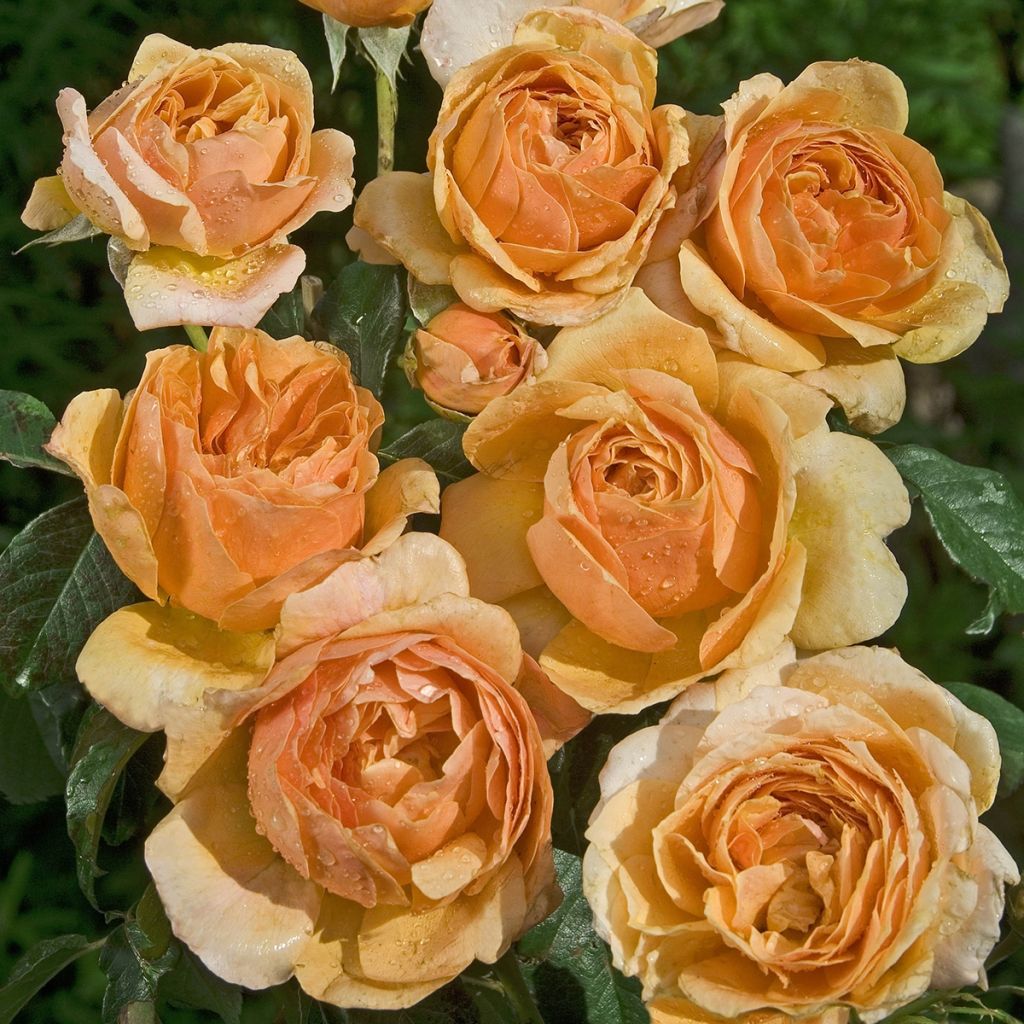

Rosa Sherlock Holmes


Rosa Sherlock Holmes


Rosa Sherlock Holmes


Rosa Sherlock Holmes
Rosa Sherlock Holmes
Rosa Sherlock Holmes 'Harklement'
Well-packaged rose bush, looks healthy, 3 well-pruned stems.
mariefrance, 29/11/2024
Special offer!
Receive a €20 voucher for any order over €90 (excluding delivery costs, credit notes, and plastic-free options)!
1- Add your favorite plants to your cart.
2- Once you have reached €90, confirm your order (you can even choose the delivery date!).
3- As soon as your order is shipped, you will receive an email containing your voucher code, valid for 3 months (90 days).
Your voucher is unique and can only be used once, for any order with a minimum value of €20, excluding delivery costs.
Can be combined with other current offers, non-divisible and non-refundable.
Home or relay delivery (depending on size and destination)
Schedule delivery date,
and select date in basket
We guarantee the quality of our plants for a full growing cycle, and will replace at our expense any plant that fails to recover under normal climatic and planting conditions.
Description
Rosa Sherlock Holmes is perhaps the best in the series of modern hybrids called English Legend. This astonishing variety combines beautiful form, delicate fragrance, strong growth, and excellent disease resistance. It bears beautiful dark green foliage. It produces fully double roses, delicately coloured in apricot-orange. They bloom for several months, emitting a beautiful spicy and fruity fragrance. It is a reliable choice for borders and flower beds. Its roses are also very beautiful in a vase.
The English Legend collection brings together roses created in England in the 1990s by the famous breeder Robert Harkness. With their repeat flowering and delicate fragrance, they express all the charm of English roses. Rosa Sherlock Holmes is a hybrid tea rose, characterised by an upright habit and vigorous growth. This bush quickly reaches about 90cm (35in) in height and 70cm (28in) in width. Its thorny stems bear reddish young shoots that unfold into dark green, shiny leaves, divided into 5 finely toothed leaflets. The foliage is not very susceptible to diseases under good growing conditions. Its flowering is long and abundant, renewing itself in successive waves from May-June to October if the soil remains moist. The flowers are solitary or gathered in small clusters of 3. They have a diameter of 8 to 10cm (3 to 4in). Their somewhat globular cups are composed of 90 petals arranged in quarters. Their fragrance is pronounced, reaching its peak at noon and in the evening, after a hot and sunny day. The foliage is deciduous, falling in autumn.
English shrub roses can be used to create beautiful small hedges, planted along the edge of a patio, or in modest-sized shrub borders. Combine them with Mexican oranges or caryopteris, for example. They make good companions for panicle phlox and tall baby's breath. Rosa Sherlock Holmes will look wonderful when planted in groups of 3, forming an extremely decorative large bush. It can be surrounded by catmints, lavenders, and perennial or shrubby salvias with blue, mauve, or white flowers. This very hardy rose requires little maintenance. It thrives in full sun or partial shade. It will delight all gardeners, whether beginners or experienced.
Report an error about the product description
Plant habit
Flowering
Foliage
Botanical data
Rosa
Sherlock Holmes 'Harklement'
Rosaceae
Cultivar or hybrid
Rosa multiflora (4L/5L pot)
Planting and care
Plant in a sunny location. English roses are tolerant, but do not like excessive limestone. They will adapt to any garden as long as the soil is well worked, not too heavy, and sufficiently rich. To plant your rose, work the soil by crumbling it and add fertiliser to the bottom of the planting hole (dried blood or dehydrated horn, for example). Water generously after planting to remove any air pockets. Water regularly for a few weeks to facilitate rooting. Provide your rose with special rose fertiliser that stimulates flowering.
Pruning bushy English roses is essential for flowering. Shorten the branches to two or three buds above the ground in spring, choosing an outward-facing bud for a more elegant habit. Remove dead wood and unsightly branches. Pruning should be done at an angle above a bud.
Regularly remove faded flowers to encourage new blooms.
Roses are often stained or unsightly at the end of summer, but this will not hinder their development. These spots are a natural phenomenon and will not harm the rose.
Planting period
Intended location
Care
-
, onOrder confirmed
Reply from on Promesse de fleurs
Similar products
Haven't found what you were looking for?
Hardiness is the lowest winter temperature a plant can endure without suffering serious damage or even dying. However, hardiness is affected by location (a sheltered area, such as a patio), protection (winter cover) and soil type (hardiness is improved by well-drained soil).

Photo Sharing Terms & Conditions
In order to encourage gardeners to interact and share their experiences, Promesse de fleurs offers various media enabling content to be uploaded onto its Site - in particular via the ‘Photo sharing’ module.
The User agrees to refrain from:
- Posting any content that is illegal, prejudicial, insulting, racist, inciteful to hatred, revisionist, contrary to public decency, that infringes on privacy or on the privacy rights of third parties, in particular the publicity rights of persons and goods, intellectual property rights, or the right to privacy.
- Submitting content on behalf of a third party;
- Impersonate the identity of a third party and/or publish any personal information about a third party;
In general, the User undertakes to refrain from any unethical behaviour.
All Content (in particular text, comments, files, images, photos, videos, creative works, etc.), which may be subject to property or intellectual property rights, image or other private rights, shall remain the property of the User, subject to the limited rights granted by the terms of the licence granted by Promesse de fleurs as stated below. Users are at liberty to publish or not to publish such Content on the Site, notably via the ‘Photo Sharing’ facility, and accept that this Content shall be made public and freely accessible, notably on the Internet.
Users further acknowledge, undertake to have ,and guarantee that they hold all necessary rights and permissions to publish such material on the Site, in particular with regard to the legislation in force pertaining to any privacy, property, intellectual property, image, or contractual rights, or rights of any other nature. By publishing such Content on the Site, Users acknowledge accepting full liability as publishers of the Content within the meaning of the law, and grant Promesse de fleurs, free of charge, an inclusive, worldwide licence for the said Content for the entire duration of its publication, including all reproduction, representation, up/downloading, displaying, performing, transmission, and storage rights.
Users also grant permission for their name to be linked to the Content and accept that this link may not always be made available.
By engaging in posting material, Users consent to their Content becoming automatically accessible on the Internet, in particular on other sites and/or blogs and/or web pages of the Promesse de fleurs site, including in particular social pages and the Promesse de fleurs catalogue.
Users may secure the removal of entrusted content free of charge by issuing a simple request via our contact form.
The flowering period indicated on our website applies to countries and regions located in USDA zone 8 (France, the United Kingdom, Ireland, the Netherlands, etc.)
It will vary according to where you live:
- In zones 9 to 10 (Italy, Spain, Greece, etc.), flowering will occur about 2 to 4 weeks earlier.
- In zones 6 to 7 (Germany, Poland, Slovenia, and lower mountainous regions), flowering will be delayed by 2 to 3 weeks.
- In zone 5 (Central Europe, Scandinavia), blooming will be delayed by 3 to 5 weeks.
In temperate climates, pruning of spring-flowering shrubs (forsythia, spireas, etc.) should be done just after flowering.
Pruning of summer-flowering shrubs (Indian Lilac, Perovskia, etc.) can be done in winter or spring.
In cold regions as well as with frost-sensitive plants, avoid pruning too early when severe frosts may still occur.
The planting period indicated on our website applies to countries and regions located in USDA zone 8 (France, United Kingdom, Ireland, Netherlands).
It will vary according to where you live:
- In Mediterranean zones (Marseille, Madrid, Milan, etc.), autumn and winter are the best planting periods.
- In continental zones (Strasbourg, Munich, Vienna, etc.), delay planting by 2 to 3 weeks in spring and bring it forward by 2 to 4 weeks in autumn.
- In mountainous regions (the Alps, Pyrenees, Carpathians, etc.), it is best to plant in late spring (May-June) or late summer (August-September).
The harvesting period indicated on our website applies to countries and regions in USDA zone 8 (France, England, Ireland, the Netherlands).
In colder areas (Scandinavia, Poland, Austria...) fruit and vegetable harvests are likely to be delayed by 3-4 weeks.
In warmer areas (Italy, Spain, Greece, etc.), harvesting will probably take place earlier, depending on weather conditions.
The sowing periods indicated on our website apply to countries and regions within USDA Zone 8 (France, UK, Ireland, Netherlands).
In colder areas (Scandinavia, Poland, Austria...), delay any outdoor sowing by 3-4 weeks, or sow under glass.
In warmer climes (Italy, Spain, Greece, etc.), bring outdoor sowing forward by a few weeks.








































